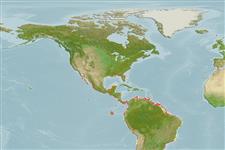Bivalvia |
Mytilida |
Mytilidae
Environment: milieu / climate zone / εύρος βάθους / distribution range
Οικολογία
. Tropical; 30°N - 29°S, 114°W - 34°W
Eastern Central Pacific and Western Atlantic: Mexico and Southern Caribbean to southeast Brazil.
Length at first maturity / Μέγεθος / Weight / Age
Γεννητική Ωρίμανση: Lm ?, range 2 - 4.296 cm Max length : 7.0 cm SHL αρσενικό/απροσδιόριστο; (Αναφ. 83435); common length : 9.0 cm SHL αρσενικό/απροσδιόριστο; (Αναφ. 344)
Shell mussel-shaped, elongate, ventral region concave. Oblique ridge runs anterodorsal to posteroventral region of valve. Umbones subterminal. Posterior part of the mantle with branching tentacles. Colour: externally greenish on posterodorsal region (above ridge) and yellowish brown on anteroventral region (below ridge).
Intertidal in bays and protected areas, forming clumps attached to mangrove prop roots or other hard substrates (Ref. 344) via its byssus (Ref. 104222). Attached to mangrove roots, particularly on Rhizophorae mangle (Ref. 104222). Some found to be buried in substrate. Also occurs in a river estuary. Highly tolerant to salinity variations (Ref. 104223). Parasitic on this mussel are Rickettsia-like organisms, Apicomplexa and Platyhelminthes (Ref. 104222). In general, suspension feeding bivalves mainly depend on phytoplankton and detritus material for nutrition (Ref. 107088).
Life cycle: Embryos develop into free-swimming trocophore larvae, succeeded by the bivalve veliger, resembling a miniature clam (Ref. 833).
Leal, J.H. 2003 Bivalves. p. 25-98. In Carpenter, K.E. (ed.). The living marine resources of the Western Central Atlantic. Volume 1: Introduction, molluscs, crustaceans, hagfishes, sharks, batoid fishes, and chimaeras. FAO Species Identification Guide for Fishery Purposes and American Society of Ichthyologists and Herpetologists Special Publication No. 5. 1600p. (Αναφ. 344)
IUCN Red List Status
(Αναφ. 130435: Version 2025-1)
CITES status (Αναφ. 108899)
Not Evaluated
Not Evaluated
Threat to humans
Harmless
Human uses
αλιεία: Εμπορικό(ά)
| FishSource |
Εργαλεία
Περισσότερες πληροφορίες
PhysiologyΚατανάλωση οξυγόνου
Human RelatedStamps, coins, misc.
Διαδικτυακές πηγές
Estimates based on models
Preferred temperature
(Ref.
115969): 24.9 - 28.7, mean 27.3 (based on 614 cells).
Fishing Vulnerability
Moderate vulnerability (40 of 100).
